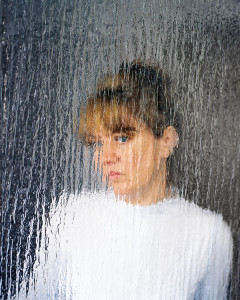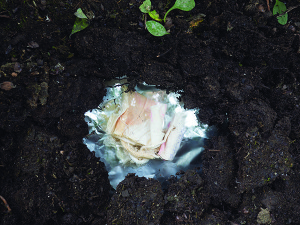Ksenia Belash is an art critic and independent researcher, currently residing in London. She holds a graduate diploma in contemporary art history from Goldsmiths, University of London. Her current research interests include photography, performance, participatory art, memory studies and sociology of everyday life.
Natalya Reznik: Secrets
When I was initially considering how to approach writing about “Secrets”, I thought of a
number of possible readings which could result from flipping through the pages of this exquisitely designed edition. Perhaps not surprisingly, the first reading that came to my mind was political, for not only does the book engage with the theme of emigration (all subjects portrayed are Russian immigrants currently residing in Germany), but it was also published in 2014 – the year which witnessed an unprecedented rise in emigration from Russia, at least partly related to the crisis in Ukraine. Yet, whilst such a reading might have seemed initially plausible, I wasn’t convinced that it would do justice to Reznik’s work: one cannot ignore the fact that the book was a result of a project accomplished in 2012, long before the aforementioned events; on the other hand, I felt that such a reading would be untrue to the very nature of the images, which are overtly poetic, imbued with the sense of melancholy and symbolism, and clearly refuse an easily imposable meaning.
In order to find a more appropriate way to tackle the secrets contained in the book, I thought that it would be helpful to consider Reznik’s background – not so much in terms of her personal biography, but rather in terms of her artistic and research interests. There are a couple of points which I would like to draw attention to in regard to “Secrets”: firstly, over the past few years, Reznik has been working on her second PhD thesis on the forms of photographic representation of aging; secondly, she was also a student and subsequently a teacher at Fotodepartament in Saint-Petersburg; the course which she taught there was called “Photography and Time”. This strong interest in the questions of temporality and representation (not surprisingly, Reznik names Barthes and Heidegger among her favourite philosophers) is manifest not only in her academic, but also in the artistic work. One can easily spot a connection between “Secrets” and two of her other recent projects: “Looking for my father” (2013) and “Memory code” (2013): all three projects, however dissimilar aesthetically, pivot around the theme of cultural memory.
In the case of “Looking for my father” it is the private memory which is being put into question and tempered with (Reznik playfully deconstructs her own family archive by interweaving elements of the collective unconscious into her family narrative, thus producing alternative versions of the past), whilst “Memory Code” explores the performative nature of memory and foregrounds the unstable border between the private remembrance and the collective recall. “Secrets” sits somewhere in between the two: it has a pronounced personal aspect (it was Reznik’s own immigration to Germany in 2011 that triggered the project) and at the same time it is also concerned with the performativity of memory, as well as with exploring and subverting the binary oppositions between “individual” and “collective”, “interior” and “exterior”, “hidden” and “seen”. There is, however, another key motif which is related to memory, yet is not as visibly present in Reznik’s other projects – namely, nostalgia.
Nostalgia is obviously a tricky term: many cultural theorists are sceptical if not outright negative about this notion, as it is seen as a way of commodifying, idealizing or narrativizing the past (Davis 1979) and “cannibalising history” (Jameson 1984, 66). Also, uncritical sentimentality, which nostalgia is often associated with, may “breed monsters” of nationalism and totalitarianism if it is left unreflected upon (Boym 2007, 10). Yet, as Boym and other writers (Radstone 2007; Turner 1987) persuasively argue, nostalgia is more than just an individually experienced emotion; in fact, this unquenchable sense of loss and longing is a symptom of our global age, in which ubiquitous processes of migration lead to traditional ties being dissolved and the very notions of “home” and “homeland” becoming destabilised. Boym, however, identifies two kinds of nostalgia: restorative, which is oriented towards coherent grand narratives, re-institution of a homogeneous collective identity and which is grounded upon an idea of the possibility of a triumphal return to the fictional “homeland” of the past and reflective, which focuses on individual memories, petits recits and on the experiences of temporality itself; it is also “inconclusive and fragmentary” (Boym, 50). It is this second type of nostalgia: disjointed, highly personal and at the same time extremely elusive, which, in my opinion, becomes the key theme of Reznik’s project.
Natalya Reznik: Secrets
So how is this theme explored and how are we, as viewers, supposed to engage with it? As I’ve mentioned above, Reznik places a strong emphasis on performativity: not only do we see photographic representations of the consequences of nostalgia, but we are ourselves encouraged (or perhaps even forced) to live through the very experience of the unrequited longing, confusion and displacement. Although we start our journey through “Secrets” by simply looking at Reznik’s heroines and the little “installations” that they created in the course of the game1 which takes place somewhere beyond the frame, we soon realize that we are also involved in some kind of game, the rules of which are not quite clear. Why is it that we are gaping at women who are clearly not welcoming our inquisitive gaze and who are trying to escape it by facing away or even by hiding behind the walls, drapery, or glass?
The pronounced voyeuristic aspect of our interaction with “Secrets” is not limited to the very precarious, personal nature of the portraits that we are presented with (and the photographs of these anonymous women are indeed very intimate, all of them taken in some private interiors), but it is also emphasized through the very design of the book, which is permeated by round holes. These holes serve a double function of perpetuating the visual form of the “secrets” (it also references the format of a children’s board book) and simultaneously serving as a kind of a peephole through which we “spy” on the photographed subjects and their secrets. However, instead of enabling a safe and unimpeded contemplation, the holes do the opposite: not only do they make us uncomfortably self-conscious about the act of our spectatorship, but they also complicate the act of looking, fragment our perception, confuse and disorient us.
There are also the secrets themselves. What is the act of calling something a secret if not a provocation, a teasing out of our desire to know, to understand, to possess the hidden meaning? “The audience demands an explanation,”- to quote one of Bulgakov’s exasperated character, who demands a public revelation of the black magic tricks performed in Cabaret Variete: “An explanation is essential, otherwise your brilliant act will leave a painful impression”. (Bulgakov 1967) And, indeed, being confronted with the unknowable can be a very painful experience. Yet what kind of unknowable are we talking about here? There appears to be nothing hidden or clandestine in these photographs: all “secret” objects are laid bare, right in front of our eyes and so are the portraits of their owners.
Yet something is clearly missing: the meaning, the sense, the story behind these emotionally charged, but mute objects. Transparency turns out to be nothing but illusion; both the portraits and the “secrets” are in fact resolutely opaque 2– “demonically ambiguous”, to quote Kracauer. (Kracauer, 1993, 426) Of course, there is some magic involved- it is the black magic of photography itself, which performs the tricks of representation and lures the viewers by its spectacle, yet, being “at odds with memory images” (Kracauer, 1993, 425) possesses no means to provide any signification to the show and leaves one with the unquenchable thirst for revelation, a sense of loss and failure – failure to understand, but also to relate and to belong. And in that respect the book performs its content: this sense of failure, loss, confusion and displacement is, in fact, very similar to what a nostalgic experiences when he is thinking of his long-left homeland.
Natalya Reznik is a photographer and art-historian. She works as a scientific editor of a Russian website dedicated to contemporary photography: Photographer.ru. She studied design at Perm State Technical University and earned a PhD in philosophy of culture in Saint- Petersburg State University. Currently she is a researcher at University of Erlangen-Nuremberg (Germany), writes her thesis in the field of theory and history of photography and makes personal photo projects. Web: http://www.reznikdavydov.com
Notes
- “Sekretiki” or “little secrets” was a game which was very popular among young Soviet girls; in fact, I also engaged in it on numerous occasions. It involved a straightforward ritual: one would dig a hole in the ground, put there a “precious” belonging (which could be anything from a foil candy wrapping, which were rare and therefore treasured to an even more valuable trinket), cover it with a piece of glass and hide the resulting “installation” with the soil. The location could only be revealed to the closest friends, however, the game didn’t necessarily presuppose sharing of the “secret” with the others. The origin of this game is not clear, however, it may have evolved from an older ritualistic game of burying pets or found dead animals and birds, which was apparently quite widespread among kids in pre-Soviet Russia.
- Some of the objects “installed” as “secrets” would be immediately recognizable by most viewers of the Soviet origin born before the nineties: a book by Dostoevsky, an audio tape, an icon-pendant, a metallic calendar which was a very characteristic attribute of a typical Soviet interior (both of my grandmothers had it, too). However, even these “recognizable” objects, whilst clearly belong to the arsenal of the collective post-Soviet memory, can only work as triggers of the viewer’s own memory; they are mirrors which don’t reveal anything about the identities of their actual owners.
Bibliography
Boym, Svetlana. The future of nostalgia. Basic Books, 2001
Boym, Svetlana. Nostalgia and Its discontents in Hedgehog Review, Vol. 9 Issue 2, 2007, pp. 7-18.
Bulgakov, Mikhail. Master and Margarita, translated by Larissa Volokhonsky and Richard Pevear. Penguin Classics, 2007.
Davis, Fred. Yearning for yesterday: a sociology of nostalgia. Free Press, 1979
Jameson, Frederic. Postmodernism, Or, The Cultural Logic of Late Capitalism in New Left Review, no. 146 (July-August), pp. 59 – 92.
Kracauer, Sigfried. Photography in Critical Inquiry, Vol. 19, No. 3, 1993, pp. 421-436.
Radstone Susannah. The Sexual Politics of Time: Confession, Nostalgia, Memory. London and New York: Routledge, 2007.
Turner, Bryan S. “A Note on Nostalgia” in Theory, Culture and Society, 1987, pp. 147-156.



